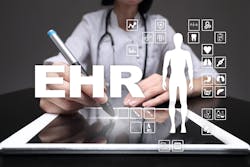On Oct. 1, at the NAACOS Fall 2021 Conference, executives from three accountable care organizations described the daunting road ahead in transitioning to the submission of electronic clinical quality measures (eCQMs) to the Centers for Medicare & Medicaid Services.
After receiving strong feedback from ACOs about how challenging (and expensive) the transition to eCQMS would be, CMS has pushed back the timeline for reporting electronically. In 2022, ACOs will still be able to report via the web interface, with an option to submit electronically, but by 2023 they will have to report at least one eCQM.
Paula Burleson, manager of government programs at North Carolina-based Novant Health, said that in 2022 her organization plans to submit through the web interface and submit all three eCQMS as a trial run to gain experience.
She said they still have concerns about data completeness and how to de-duplicate data. Novant’s EHR vendor, Epic, “is releasing a tool that will allow us to aggregate some of our data into one single QRDA III file for submission, but we will not get that tool until next year.”
Burleson said Novant started mapping eCQMs in 2017, its first year as an ACO. “Seeing the writing on the wall, we realized that we would eventually need to move to eCQM reporting,” Burleson said, so Novant got started early. It involves doing a lot of complicated terminology mapping in Epic, and requires consolidating how they define some common measures. “As an organization, we have to involve lots of clinicians in the decision-making, because the workflow might differ if the measure is specified differently, or even if exclusions are specified differently,” she said.
She said it is a process that is ever-changing. Draft eCQM specifications come out during the reporting season for the year prior, she noted. “So oftentimes, as soon as we've submitted our data, we're pivoting right away in February or March to begin looking at what the draft specifications are for the current year.”
Megan Reyna, vice president of government and value-based programs at Downers Grove, Ill.-based Advocate Aurora Health, used their ACO in Illinois as an example of the complexity level they are dealing with. Sixty percent of the ACO is made up of independent physicians and they have 422 TINs (taxpayer identification numbers), including lots of specialists. They use more than 65 different EHRs. The fact that many practices report switching EHRs “is going to be a challenge with eCQM reporting,” she said.
Initially, Advocate Aurora is turning to an outside vendor to help with data validation and reporting. “We realized early on that our quality staff was not used to eCQM reporting, so there was a knowledge gap there. We do have some technical expertise internally, but when we were thinking about combining 65 different EHRS initially, we realized we needed a vendor to help us. Ideally, we will learn from that vendor how to potentially one day take this over.”
“It is great that CMS gave us extra time,” Reyna added. “I am a big advocate that we are going down this road with CMS to do electronic reporting, and once we do end up getting the infrastructure in place to do electronic quality reporting, I think that will benefit us as ACOs. But right now we have to focus and it is a big change for us.”
She said Advocate Aurora is talking to providers about the reporting capabilities in their EHRs. All their members use a 2015 certified EHR, she noted, but not all 2015 certified EHRs are created equal. “We've had several of our independent practices, which we call aligned practices, come back to us and tell us that their vendors are charging them by the eCQM to create this report.”
Reyna stressed that eCQM reporting is much more about workflow and where they are documenting in the EHR vs. just quality of care. “With our web interface, if we needed to go back into the practice and abstract data, we could find it and abstract that colonoscopy. But now if they're not documenting the colonoscopy in the place that the vendor is telling you it needs to be documented, it's not going to be collected.”
Michael Van Scoy, M.D., medical director at Essentia Health, an integrated healthcare system with facilities in Minnesota, Wisconsin, and North Dakota, described some of the heavy lift involved in getting ready for eCQMs.
“How do we represent what the lift is for a healthcare system if you have to look to a vendor to submit your eQCMs?” he asked. “I think that's going to be pretty expensive whether you build or buy. One of the barriers that we find is that we have to locate all patients who are eligible and report on them. We have to find out which patients are seeing other specialists, and what their quality activity has been.”
Some outside primary care practices refer specialty care to Essentia, and Essentia refers some primary care patients to non-Essentia Health specialty practices. “So we have an issue of identifying which patients are in the denominator and de-duplicating them,” Van Scoy said. “That's going to be an issue for us.”
Essentia’s web interface reporting requires about 180 analyst hours every year. “Next year, 2022, we're still going to have those 180 analyst hours, because we're still going to be using a web interface in combination with eCQMs,” Van Scoy explained. “We're in a discovery phase in terms of what it will cost us to build that. We're also looking at analyst time to identify all eligible patients and de-duplicate them. We don't know how much that's going to cost us just yet. In our NAACOS advocacy work, we meet with our congressional staff teams in North Dakota, Minnesota, and Wisconsin, and tried to share with them that we did earn $10 million in our portion of the shared savings this year. But there's a lot of built-in cost in the EHR and our staff to get to that point.”
The ACO executives all agreed that once the electronic reporting infrastructure was in place, it would be a vast improvement for everyone involved. Getting there, however, is going to require lots of work.


